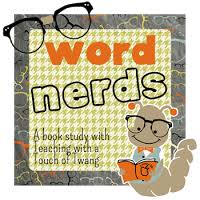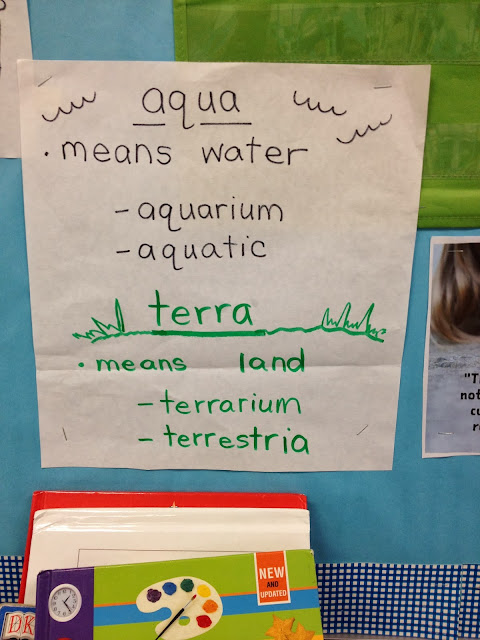Have you ever wondered why we continue to teach the same thing over and over again...even when we know it isn't working for 80% of the kids? We hear "we've always done this". "It covers the standards." But if it isn't working, then why do we continue to waste time on it???
 This summer I noticed a lot of chatter on Pinterest about the book Word Nerds. I figured I needed to read this book!
This summer I noticed a lot of chatter on Pinterest about the book Word Nerds. I figured I needed to read this book!
Guess what? I loved it! When my team and I got together to plan for the upcoming year, we discussed the ideas in the book and decided it was worth a try.
 First idea: Vocabulary should not be random words. Instead they should be purposefully picked to tie into the curriculum in your classroom during the two week vocabulary cycle. I also feel strongly that the words need to be experienced in order to connect meaning - rather through a science investigation, a math activity or a social studies role play. Together, we searched through our curriculum to find words that would overlap in science, social studies and math content. Words such as position, rapidly, current, prior and more. We pick six words for the week.
First idea: Vocabulary should not be random words. Instead they should be purposefully picked to tie into the curriculum in your classroom during the two week vocabulary cycle. I also feel strongly that the words need to be experienced in order to connect meaning - rather through a science investigation, a math activity or a social studies role play. Together, we searched through our curriculum to find words that would overlap in science, social studies and math content. Words such as position, rapidly, current, prior and more. We pick six words for the week.
Second: Once we choose the words, we create a vocabulary guide sheet for the teachers. This is really powerful for us. It helps keep vocabulary consistent in each room as well as the skills we want to address. As you see, we also add antonyms, synonyms, prefixes and suffixes to our basic six words.

 Third: The students are finally introduced to the words. First present cloze sentences in which the students predict what the words will be. Next, share the words (I do it one at a time) while the students guess which words fit in which sentences. (Oh yes, that would be context clues!) Next the kids are given a vocabulary journal that is full of Frayer Model graphic organizers. I bought this vocabulary journal at TPT for just $1.00. It's a great buy! We are lucky to have laptops that we share as a grade level. Students work as pairs to search for the new vocab word, find antonyms (if there are some), synonyms, and a definition in kid friendly language. Then they draw a picture and write a 7 up sentence (with at least 7 words). The kids like the ownership of searching for the words themselves. Sites we use include www.dictionary.com and www.yourdictionary.com .
Third: The students are finally introduced to the words. First present cloze sentences in which the students predict what the words will be. Next, share the words (I do it one at a time) while the students guess which words fit in which sentences. (Oh yes, that would be context clues!) Next the kids are given a vocabulary journal that is full of Frayer Model graphic organizers. I bought this vocabulary journal at TPT for just $1.00. It's a great buy! We are lucky to have laptops that we share as a grade level. Students work as pairs to search for the new vocab word, find antonyms (if there are some), synonyms, and a definition in kid friendly language. Then they draw a picture and write a 7 up sentence (with at least 7 words). The kids like the ownership of searching for the words themselves. Sites we use include www.dictionary.com and www.yourdictionary.com .
Guess what? I loved it! When my team and I got together to plan for the upcoming year, we discussed the ideas in the book and decided it was worth a try.
 First idea: Vocabulary should not be random words. Instead they should be purposefully picked to tie into the curriculum in your classroom during the two week vocabulary cycle. I also feel strongly that the words need to be experienced in order to connect meaning - rather through a science investigation, a math activity or a social studies role play. Together, we searched through our curriculum to find words that would overlap in science, social studies and math content. Words such as position, rapidly, current, prior and more. We pick six words for the week.
First idea: Vocabulary should not be random words. Instead they should be purposefully picked to tie into the curriculum in your classroom during the two week vocabulary cycle. I also feel strongly that the words need to be experienced in order to connect meaning - rather through a science investigation, a math activity or a social studies role play. Together, we searched through our curriculum to find words that would overlap in science, social studies and math content. Words such as position, rapidly, current, prior and more. We pick six words for the week.Second: Once we choose the words, we create a vocabulary guide sheet for the teachers. This is really powerful for us. It helps keep vocabulary consistent in each room as well as the skills we want to address. As you see, we also add antonyms, synonyms, prefixes and suffixes to our basic six words.

Fourth: Now, we meet up again and share words that the kids have found. We add them to our class chart (and anymore that we have found in the planning phase) and post the chart in the room. All of these parts take about three days to complete. So what do we do for the rest of the two week cycle? Oh that will be another post!




















